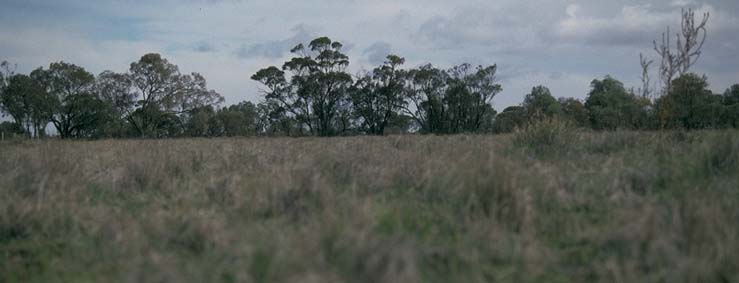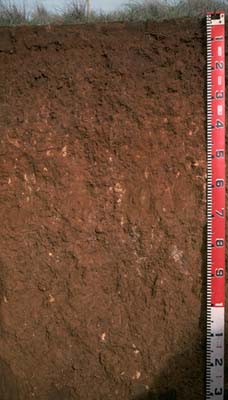LP71
| Group: Oakvale Farm Advance Group | Australian Soil Classification: Calcic, Hypernatric, Red SODOSOL |
| Northcote Factual Key: Dr 2.13 | Great Soil Group: solodic soil |
| General Landscape Description: Drainage way on level plain. Original vegetation included Buloke (Casuarina luehmanni). This site has not been cropped. | |
 LP71 Landscape |
Soil Profile Morphology
Surface Soil
| A1 | 0-8 cm | Reddish brown (5YR4/4); light fine sandy clay loam; hardsetting surface condition; weak coarse blocky structure; firm consistence moist; pH 7.4; sharp change to: |  LP71 |
| Subsoil | |||
| B21 | 8-25 cm | Yellowish red (5YR4/4); light medium clay; strong medium blocky structure; firm consistence moist; pH 7.5; clear change to: | |
| B22k | 25-50 cm | Yellowish red (5YR5/6); medium clay; strong medium blocky structure; strong consistence dry; contains a few (2-5%) soft carbonates and very few (<1%) semi-hard carbonates (up to 10 mm diameter); pH 8.2; clear change to: | |
| B23 | 50-100 cm | Strong brown (7.5YR5/6); and yellowish red (5YR5/6); medium clay; moderate blocky structure (earthy fabric); strong consistence dry; contains a few (2-5%) fine gypsum crystals in pockets as well as very few (<2%) carbonate nodules (5-8 mm diameter); pH 8.8; gradual change to: | |
| B24 | 100+ cm | Strong brown (7.5YR5/6); medium clay; strong medium blocky, parting to strong fine polyhedral structure (with shiny faced peds); very strong consistence dry; contains very few (<2%) hard and semi-hard carbonates (10-20 mm diameter); pH 8.9. | |
Key Profile Features
- Strong texture contrast between surface (A) horizon and top of the subsoil (B21) horizon.
- Calcareous and sodic subsoil.
Key Profile Characteristics
pH | Salinity Rating | |||
Surface (A1 horizon) | slightly alkaline | low | non-sodic | none1 |
Subsoil (25-45 horizon) | slightly alkaline | low | sodic | slight - moderate |
Deeper subsoil (1 m) | strongly alkaline | medium | strongly sodic | none2 |
| 1 Strong dispersion with remoulding. 2 Due to high level of soluble salts. | ||||
 |
Horizon | Horizon Depth | pH (water) | pH CaCl2 | EC 1:5 | NaCl | Exchangeable Cations | |||
Ca | Mg | K | Na | ||||||
meq/100g | |||||||||
A1 | 0-8 | 7.4 | 6.7 | 0.09 | 7.4 | 3.2 | 1.6 | 0.2 | |
B21 | 8-25 | 7.5 | 6.6 | 0.14 | 2.7 | 2.4 | 0.7 | 0.9 | |
B22 | 25-50 | 8.2 | 7 | 0.21 | 5.5 | 6 | 0.8 | 4.2 | |
B23 | 50-100 | 8.8 | 8.3 | 0.55 | 0.39 | 5.2 | 9.3 | 1.2 | 9.5 |
B24 | 100+ | 8.9 | 8.4 | 0.55 | 0.44 | 5.1 | 11 | 1.2 | 11 |
Horizon | Horizon Depth | Ex Al mg/kg | Ex Ac meq/100g | Field pF2.5 | Wilting Point pF4.2 | Coarse Sand (0.2-2.0mm) | Fine Sand (0.02-0.2mm) | Silt (0.002-0.02mm) | Clay (<0.002mm) |
A1 | 0-8 | 16.6 | 6.3 | 20 | 50 | 13 | 15 | ||
B21 | 8-25 | 29 | 7.7 | 15 | 30 | 9 | 44 | ||
B22 | 25-50 | 35.6 | 20.9 | 12 | 28 | 6 | 51 | ||
B23 | 50-100 | ||||||||
B24 | 100+ |
Management Considerations:
Surface (A) Horizons
- The surface horizon is hardsetting and has a high fine sand (50%) content. When cultivated in a dry condition, these soils will become "powdery" and subsequent rain may form a surface crust. Maintaining adequate organic matter levels is important to assist in reducing structural degradation (e.g. compaction) and hardsetting on such soils. Practices such as minimum tillage, stubble retention and pasture rotation should be encouraged if cropping occurs.
- The surface soil disperses strongly after remoulding. Over-stocking or excessive cultivation of these soils when wet may result in surface sealing and exacerbation of the hardsetting condition. Raindrop action can have a similar effect to remoulding, so maintaining a protective cover of plants or stubble is important.
Subsoil (B) Horizons
- The strongly alkaline subsoil (from 50 cm depth) suggests that some nutrients (e.g. copper, iron, manganese and zinc) may be poorly available at depth.
- The coarsely structured subsoil is strongly sodic and disperses strongly in water. This is likely to significantly restrict root and water movement through the profile.
- From 50 cm in depth the salinity rating is medium (based on sodium chloride levels measured in the laboratory). This level may restrict the growth of salt sensitive species (e.g. maize, linseed, faba beans, chickpeas and some other legumes).
Notes
- Repeats of analyses are being done for some of the horizons at this site, due to some irregular results.


